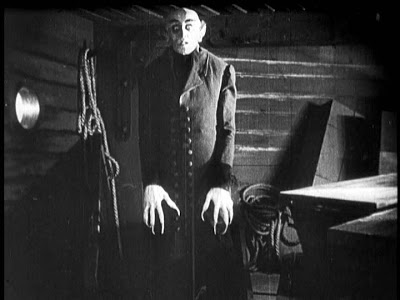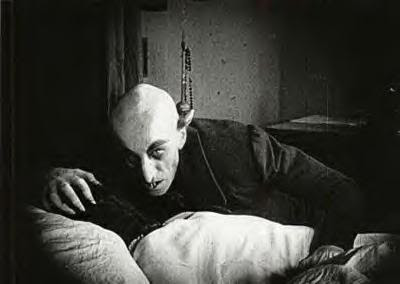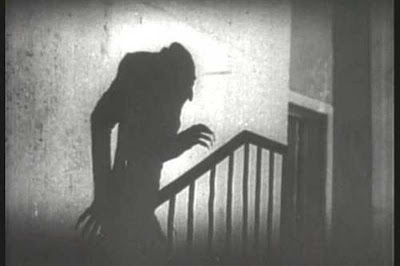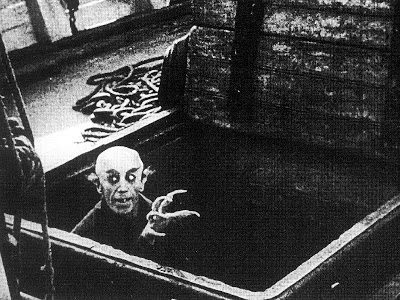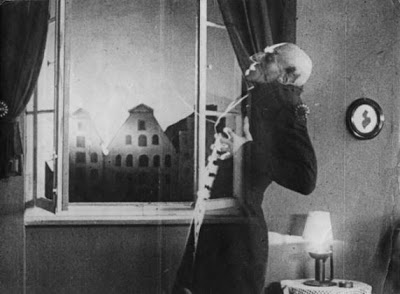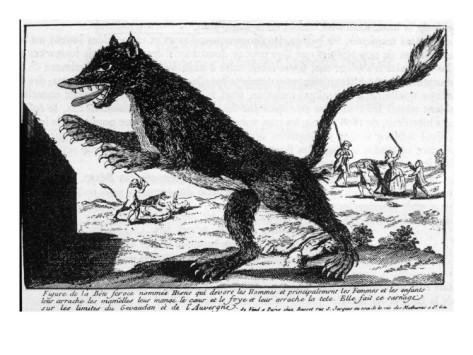
Vampires are one of the classic monsters and one of the oldest.
The idea of the hungry dead dating well back in time to ancient Babylon and the demonic entity Lilitu, known better today as the Hebrew Lilith and her progeny the Lilu or Lilin.
These creatures were not what we think of them today, but were indeed vampires. They were not undead, and closer to being demons than human.
Other mythologies blended together to create what we call a vampire today.
In fact, folklorists will often ascribe the name vampire to any nocturnal supernatural predator that feeds on blood or ‘life essence’.
It’s even more confusing than it sounds.
Basically, there is no standard vampire, but the monster from the movies is a far cry from the mythic origins.
That said, Nosferatu: A Symphony of Horror, however, has a very different sort of vampire—largely because it is the oldest one put to film.
Symbolism
The vampire in Nosferatu has symbolism closer to the original use of vampires in folklore as opposed to what they became in popular culture.
Today, vampires symbolize both sex and death in varying degrees. I’ll get to more on that in other vampire posts.
Orlok, however, is just death, derived from something else entirely.
Which is rather odd. Stoker’s Dracula was the first to make vampires that combination (and Orlok was originally going to be Dracula until the rights fell through). Today, sadly, the most popular vampires are all sex, but that’s an article for another time.
Once I find enough liquid courage to put myself through one of those films…
Anyway, like the vampires of the middle ages and renaissance, Orlok is a plague. Possibly the plague, but disease is the primary point of the monster. His iconic animal is not the bat, but the rat. To be literal about it, he carries the plague with him as he goes (or, at least, the people treat his appearance in town as though they were struck by the plague), making the link to his symbolism blatant.
Plague leads to death, and the vampires of folklore like Orlok are ‘living corpses’. Orlok looks like a partially rotted corpse. The overgrown eyebrow and ear hair as well as the long nails were long considered to be signs of continued life after death in vampirism. Today, we know that it’s an illusion created by the dehydration of the body, the skin shrivel shrink slightly, making it seem the hair and nails are continuing to grow. Furthermore, the film’s use of Orlok’s shadow and his residence in dilapidated locations emphasize these points.
His ability to phase through objects (described below) further links him to the concept of being not a living thing but a spirit. However, unlike the novel Dracula and many later vampires, he does have a reflection, which destroys the concept.
Oops.
Biology
The most important aspect of any vampire is its bite. Count Orlok has some of the oddest dentition of any movie vampire—in that he actually has teeth arranged like a vampire bat’s. His incisors are long and pointy, almost rat-like if they were not conical. However, they are not used like an actual vampire bat’s fangs. Instead, they appear to operate like the proboscis of mosquitoes, creating two small puncture marks and draining through them. The first victim of a feeding, Hutter, at first dismisses the bite marks as mosquito bites.
The way Orlok feeds and how Hutter reacts to it implies that the bite, likely through the saliva, contains a narcotic or paralytic agent. Each time Hutter is bitten, he blacks out and has little memory of the initial attack. Further, he’s left woozier than simple anemia would imply.
Or audiences in 1922 were just extremely squeamish.
Physically, Orlok resembles the vampire of folklore than the one of the movies as described above.
In a predator, the nails could very well act as claws and the ear and eyebrow exaggeration might be there to keep dirt and dust out of those areas, given it lives and rests primarily in dirty and dark environments.
Orlok has both superhuman strength and, in short bursts, superhuman speeds thanks to the glory of under-cranking. Both of these became rather standard for vampires, one to catch prey, the other to pin them down. The strength stems a bit from folklore, drawing from the condition known as “Sleep Paralysis” which has been linked to everything from vampire attacks, hag-assaults and alien abductions.
Rats also follow him wherever he goes, living in the “damned soil” he needs to sleep in. They could be forming a mild symbiotic relationship, or he is commanding them. Plague conditions follow him when he enters Wisborg (the town in the film)—and rats are well known carriers of such viruses. Many of the rats seen on film are varieties of fancy rats—rats designed to be pets with spotted coats and tame attitude. This may mean that the rats Orlok travels with are actually his pets. I guess even blood sucking monsters made from corpses have a soft spot for cute things.
If you call rats cute.
Orlok is like many later, very strong vampires and is given other supernatural powers in addition to the standard vampire attributes. Unlike later vampire films, this is not the ability to shape shifting into various other animals, nor is it a hypnotic gaze.
The powers displayed by Orlok are far more esoteric.
These powers include the ability to command his steeds even from inside his coffin and the ability to phase through solid objects like a ghost. He does not use his phasing power often, but he does employ it. Further, Orlok displays the ability to move objects without touching them. This is either the ability to command spirits to move objects or outright telekinesis (the term only having been invented 30 years prior). It may be the former as it would also combine with the command of his steeds and his later apparent spell craft to create his “Renfield” (Knock).
Early in the film, Knock is given the document expressing the count’s interest in purchasing a home in Wisborg, it has several occult symbols and magic circles impressed on it rather than being actual legal texts. Orlok later is seen reading a similar document with the same magic circles. It is implied that this black magic is how he gained control over Knock.
The Mail is Orlok’s mundane and most useful power. It sends his spells and himself to the victims he wishes (and anyone who is along the way).
A vampire using the mail sounds like some modern subversive thing, but it’s as old as vampire cinema.
Orlok does not display many weaknesses and only two are even remotely known: a yearning for the blood of a willing woman, the need for damned soil to rest in and sunlight being the only ones displayed. The last weakness is an invention of Hollywood but works symbolically in most cases: a creature of the night being banished by the rising sun combined with the sacrifice work thematically with the mythology.
In folklore, it just made them weaker or was their time to sleep and nothing more.
Biologically, there is one thing that can be said: animals will often behave oddly when faces with a highly stimulating substance. There’s nothing biological, however, that would make a beautiful woman’s blood taste better than any others, though. It works more on symbolism and magic than science.
And boy, do they try for some science in this movie, with their version of Van Helsing (Professor Bulwer) comparing a Venus fly trap to a ‘vampire’ and a translucent hydra to a ‘phantom’. But it’s the lore than wins out in this film—probably because the scientist in this movie is, by all accounts, an idiot.
As a side note, I’d be remiss if I did not note the stripped hyena that masquerades as a “Werewolf” (sometimes translated as “Dark Spirits” in sum translations) in Orlok’s home country.
The most famous werewolf case recorded, the Beast of Gevaudan, has been in recent times deduced as having been an aristocrat’s exotic pet: the spotted Hyena. A fun bit of parallelism.


































































































